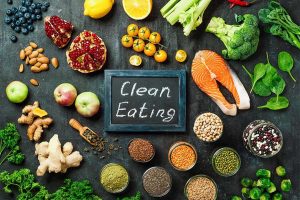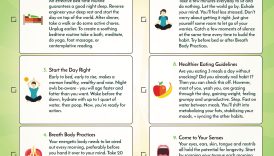Eating Clean: The Foundation of a Healthy Lifestyle

Importance of Eating Clean
In today’s fast-paced world, the concept of clean eating has gained significant traction. This approach to food focuses on consuming whole, minimally processed ingredients and steering clear of additives and artificial substances. By prioritizing clean eating, individuals not only nourish their bodies but also foster a better relationship with food. For instance, consider Jane, who made the switch to clean eating. Over time, she noticed increased energy levels, improved digestion, and even clearer skin. These personal transformations highlight how integral clean eating is to overall well-being.
- Eating Clean: The Foundation of a Healthy Lifestyle
- Importance of Eating Clean
- Benefits of a Healthy Lifestyle
- What is Clean Eating?
- Definition and Principles
- Common Myths Debunked
- The Impact of Processed Foods
- Health Risks Associated
- Tips for Avoiding Processed Foods
- Incorporating Whole Foods into Your Diet
- Importance of Whole Foods
- Types of Whole Foods to Include
- Meal Planning and Preparation
- Tips for Meal Prepping
- Healthy Recipe Ideas
- Understanding Food Labels
- How to Read Food Labels
- Key Ingredients to Avoid
- Benefits of Organic and Locally Sourced Foods
- Advantages of Organic Produce
- Supporting Local Farmers
- The Role of Hydration in Clean Eating
- Importance of Drinking Water
- Healthy Beverage Options
- Mindful Eating Practices
- Practicing Mindful Eating
- How to Listen to Your Body
- Combating Cravings and Overeating
- Strategies for Managing Cravings
- Tips for Portion Control
Benefits of a Healthy Lifestyle
Embracing a healthy lifestyle extends beyond just food choices. It encompasses hydration, physical activity, and mindfulness, all contributing to a vibrant life. The benefits include:
- Enhanced mood and mental clarity
- Reduced risk of chronic diseases
- Improved physical fitness
Ultimately, adopting healthy habits can lead to a more fulfilling and active life, akin to Jane’s enlightening experience. This holistic approach not only enhances physical health but also uplifts psychological wellness, proving that the benefits of clean eating are truly multifaceted.
What is Clean Eating?
Definition and Principles
Clean eating revolves around the idea of consuming whole foods that are as close to their natural state as possible. This means prioritizing unprocessed foods such as fruits, vegetables, whole grains, and lean proteins while minimizing processed items filled with additives and excess sugars. The principles of clean eating can be summed up as:
- Whole Foods: Choose fresh ingredients over packaged ones.
- Minimal Processing: Opt for foods that have undergone little to no industrial processing.
- Mindful Eating: Be conscious of portion sizes and savor every bite.
Take Mark, for example, who shifted to clean eating. By focusing on whole foods, he discovered new flavor profiles and enjoyed cooking again.
Common Myths Debunked
Despite its growing popularity, clean eating is surrounded by myths. Here are a few misconceptions:
- Myth 1:Clean eating is restrictive.
- Reality: It’s about choices, not deprivation. You can still enjoy a variety of foods.
- Myth 2:Clean eating is expensive.
- Reality: Seasonal produce and home-cooked meals can be budget-friendly.
Understanding what clean eating truly entails can empower individuals on their journey towards a healthier lifestyle, just like Mark’s successful transition.
The Impact of Processed Foods
Health Risks Associated
As we delve deeper into the world of clean eating, it’s essential to recognize the health risks associated with processed foods. These items often contain excessive sugars, unhealthy fats, and preservatives that can negatively impact overall health. For instance, research shows a direct correlation between high consumption of processed foods and an increased risk of:
- Obesity: Excess calories from sugary snacks contribute to weight gain.
- Heart Disease: Trans fats and high sodium levels can elevate blood pressure.
- Diabetes: High glycemic indexes in processed foods can lead to insulin resistance.
Take Sarah, who noticed significant fatigue after consistently eating processed foods. Once she made the switch to whole foods, her energy levels soared.
Tips for Avoiding Processed Foods
To reduce processed food intake, consider these practical tips:
- Plan Meals: Create a weekly menu focusing on fresh ingredients.
- Grocery Smart: Stick to the perimeter of the store where whole foods are typically found.
- Read Labels: Become familiar with ingredient lists to avoid hidden additives.
By adopting these strategies, individuals can replace processed foods with nutrient-rich alternatives, enhancing overall well-being just like Sarah did.
Incorporating Whole Foods into Your Diet
Importance of Whole Foods
Transitioning from processed to whole foods can feel like a daunting task, yet it’s incredibly beneficial for your health. Whole foods are rich in nutrients, vitamins, and minerals, providing essential nourishment that processed foods often lack. For example, Jamie, who decided to focus on whole foods, found that not only did her mood improve, but her digestive issues diminished significantly. The importance of whole foods lies in their ability to:
- Boost Energy: Whole foods provide sustained energy compared to the quick spikes and crashes from processed snacks.
- Prevention of Disease: Regularly consuming nutrient-dense foods can lower the risk of chronic conditions.
- Enhanced Digestion: High fiber content promotes a healthy digestive system.
Types of Whole Foods to Include
When considering what to add to your diet, focus on these whole food categories:
- Fruits and Vegetables: Fresh produce like spinach, berries, and oranges.
- Whole Grains: Brown rice, quinoa, and whole grain bread.
- Nuts and Seeds: Almonds, chia seeds, and flaxseed provide healthy fats.
- Lean Proteins: Options like chicken, fish, and legumes.
Incorporating these foods can help create a balanced diet and prompt positive changes in your health, much like Jamie experienced.
Meal Planning and Preparation
Tips for Meal Prepping
Now that you’ve embraced whole foods, it’s time to make healthy eating more manageable through meal planning and preparation. Effective meal prepping can save time, reduce stress, and help maintain a clean eating lifestyle. For instance, when Lisa began meal prepping, she found that her weeknights became less hectic and more enjoyable. Here are some tips to get started:
- Plan Ahead: Dedicate a specific day each week to plan meals and create a shopping list.
- Batch Cooking: Prepare large portions of grains, proteins, and vegetables, which can be mixed and matched throughout the week.
- Use Clear Containers: Store meals in transparent containers for easy visibility and access.
- Experiment with Freezing: Cook double and freeze leftovers for quick future meals.
Healthy Recipe Ideas
Here are a few healthy recipes to inspire your meal prep:
- Quinoa Salad: Mix cooked quinoa with diced vegetables, chickpeas, and a light vinaigrette.
- Roasted Vegetables: Toss seasonal veggies with olive oil, salt, and pepper, then roast them to perfection.
- Overnight Oats: Combine rolled oats with almond milk, chia seeds, and your favorite fruits for a quick breakfast.
By incorporating these tips and recipes into your routine, you’ll be well on your way to maintaining a nutritious diet, just like Lisa did.
Understanding Food Labels
How to Read Food Labels
Navigating the grocery store can sometimes feel overwhelming, especially with the plethora of food labels available. Knowing how to read these labels is crucial for maintaining a clean eating lifestyle. For instance, when Alex first started focusing on clean eating, he discovered that understanding labels allowed him to make healthier choices. Here are some key components to pay attention to:
- Serving Size: Always check the serving size, as many people underestimate how much they actually consume.
- Nutritional Information: Look for calories, fats, sugars, and fiber content. Aim for lower sugars and higher fiber.
- Ingredients List: Ingredients are listed in order of quantity, so the first few items should ideally be whole foods.
Key Ingredients to Avoid
When reading labels, it’s essential to identify harmful additives. Here are some ingredients to steer clear of:
- High-Fructose Corn Syrup: A cheap sweetener linked to obesity.
- Trans Fats: Often found in processed snacks, these can raise bad cholesterol levels.
- Artificial Preservatives: Such as BHA and BHT, which can lead to health concerns.
By equipping yourself with this knowledge, you’ll transform grocery shopping into a more informed and empowered experience, just like Alex did on his clean eating journey.
Benefits of Organic and Locally Sourced Foods
Advantages of Organic Produce
Shifting your focus to organic produce can be a game-changer in your clean eating journey. Organic foods are grown without synthetic fertilizers or pesticides, which not only benefits your health but also the environment. Sarah, for example, noticed a significant improvement in her family’s energy levels when she opted for organic fruits and vegetables. Key advantages of organic produce include:
- Fewer Chemicals: Organic farming practices reduce exposure to harmful substances.
- Higher Nutritional Value: Some studies suggest that organic foods may have higher antioxidant content.
- Better Flavor: Many people find organic fruits and vegetables tastier due to their natural growth processes.
Supporting Local Farmers
In addition to choosing organic, sourcing food locally has its unique benefits. Buying from local farmers:
- Boosts the Local Economy: Your dollars support local businesses and farmers, helping to create jobs.
- Freshness and Flavor: Foods picked at their peak ripeness are often more flavorful and nutritious.
- Sustainable Practices: Local farms may use sustainable farming methods that benefit the environment.
By incorporating both organic and locally sourced foods into your diet, you’re not only enhancing your health but also making a positive impact on your community, mirroring Sarah’s fulfilling experience.
The Role of Hydration in Clean Eating
Importance of Drinking Water
As we explore clean eating further, it’s crucial not to overlook hydration. Drinking water plays a vital role in our health, aiding digestion, nutrient absorption, and mood regulation. Rachel, for example, realized that after increasing her water intake, she felt more energized and clear-headed throughout the day. Here’s why staying hydrated is essential:
- Maintains Bodily Functions: Water is necessary for every cell, helping to regulate temperature and improve circulation.
- Supports Weight Management: Sometimes, feelings of hunger are actually signs of dehydration. Drinking water can help curb unnecessary snacking.
- Improves Skin Health: Proper hydration can lead to more radiant, healthier skin.
Healthy Beverage Options
Beyond water, there are several healthy beverage choices that complement your clean eating lifestyle:
- Herbal Teas: Naturally caffeine-free and full of antioxidants.
- Coconut Water: A hydrating option with natural electrolytes.
- Infused Water: Add fruits or herbs for flavor without added sugars.
Incorporating these beverages into your diet ensures good hydration, much like Rachel’s experience, enhancing overall health while supporting your clean eating goals.
Mindful Eating Practices
Practicing Mindful Eating
As you delve deeper into clean eating, incorporating mindful eating practices can significantly enhance your experience. Mindful eating encourages you to focus on the flavors, textures, and sensations of your meals, fostering a deeper connection with your food. When Mia started practicing mindful eating, she found that she enjoyed her meals more and wasted less food. To embrace mindful eating, consider these tips:
- Eliminate Distractions: Set aside meals for undistracted time, away from screens and noise.
- Savor Each Bite: Take your time to appreciate the taste and texture of your food.
- Use Smaller Plates: This can help control portions while allowing you to focus on what you’re eating.
How to Listen to Your Body
Listening to your body is essential in mindful eating. Here are ways to tune into your body’s signals:
- Hunger Cues: Eat when you’re genuinely hungry rather than out of habit.
- Satisfaction Levels: Stop eating when you’re comfortably full, not stuffed.
- Reflect on Emotions: Notice if you’re eating due to stress or boredom, and acknowledge those feelings without judgment.
By adopting these practices, just like Mia did, you can create a more gratifying and nutritious eating experience, aligning your habits with your clean eating journey.
Combating Cravings and Overeating
Strategies for Managing Cravings
As you continue on your clean eating journey, it’s common to encounter cravings and moments of overeating. Understanding how to combat these feelings can make a significant difference in maintaining your healthy lifestyle. When Jake started to experience frequent cravings for sugary snacks, he discovered a few effective strategies that helped him regain control. Here are some tips to manage cravings:
- Stay Hydrated: Sometimes thirst can be mistaken for hunger, so drinking water can help curb cravings.
- Healthy Alternatives: Keep healthy snacks on hand, like nuts or fruit, to satisfy your cravings without derailing your progress.
- Mindfulness: Recognize when a craving arises and ask yourself if you’re truly hungry or if it’s an emotional response.
Tips for Portion Control
Practicing portion control is equally important in avoiding overeating. Here are practical tips to consider:
- Use Smaller Plates: Serving meals on smaller dishes can help trick your brain into thinking you’re eating more.
- Pre-Portion Snacks: Divide snacks into small, resealable bags to avoid mindless nibbling.
- Listen to Your Body: Pay attention to your hunger and fullness cues, so you know when to stop eating.
By implementing these strategies, much like Jake did, you can navigate cravings and portion sizes while staying committed to your clean eating goals.




